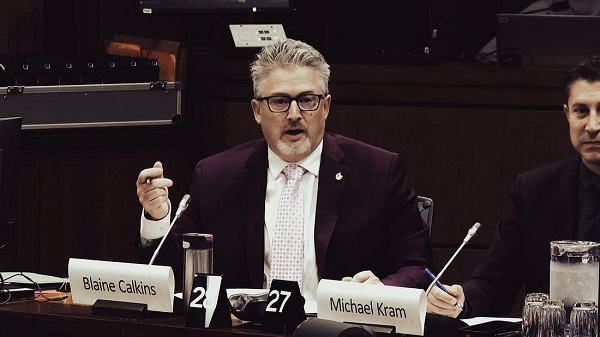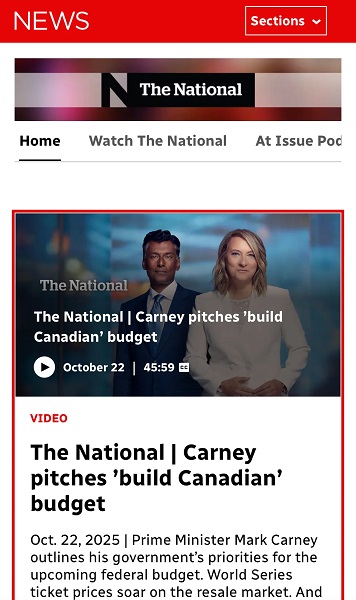Alberta
Investigation concludes police shooting of suspect holding gun a reasonable use of force

From the Alberta Serious Incident Response Team
RCMP used reasonable force during serious injury incident
On April 29, 2019, the Alberta Serious Incident Response Team (ASIRT) was directed to investigate the circumstances surrounding injuries sustained by a 33-year-old man during his arrest by members of the Lloydminster RCMP that same date.
On that date, members of the Lloydminster RCMP observed a male driver operating a stolen Dodge Ram 2500 truck within Lloydminster city limits. The truck had been stolen earlier that day during a break and enter at a local vehicle repair shop. Video footage from the repair shop depicted the 33-year-old man as the individual responsible for the break and enter, and at the time, the man was also under investigation in relation to a homicide that had occurred on April 27, 2019.
Police attempted to conduct a traffic stop on the stolen truck, but the truck fled. Officers elected not to pursue the vehicle; however, the vehicle was known to have engine problems and was not expected to be drivable for long. A short time later, two police officers observed the stolen truck in an industrial area of the city. In order to avoid a pursuit, both officers followed the truck from a distance until they observed plumes of smoke emanating from the truck, leading them to believe that the vehicle’s engine had failed.
The two officers stopped their fully marked police vehicles in front of and behind the truck, blocking its path. The man exited the driver’s side door of the truck and fled on foot toward the rear of the truck and into a fenced compound. One of the police officers pursued the man on foot while the second ensured the stolen truck was empty before joining the foot pursuit a short distance behind. As the first officer ran, he called out to the man by name, advising him that he was under arrest. The man continued to run, but soon lost his footing and stumbled on the gravel. The officer drew his conducted energy weapon (CEW) and issued a verbal command for the man to stay down. When the man rose to his feet and began running again, both officers observed a black handgun in the man’s right hand. The first officer radioed that the man had a gun, then drew his service pistol from its holster and issued repeated verbal commands for the man to drop the gun. The man continued running and, as he rounded the corner of a building, he pointed the handgun at the pursuing officer, who then fired his service pistol.
After the officer fired, the man ran behind a parked Volkswagen Jetta. As he turned to get behind the Jetta, still holding the gun in his right hand, the officer fired again. The man ducked behind the car as the officer fired at him through the window of the parked Jetta. The second officer described the man’s actions as a tactical movement to use the vehicle as cover, and after the first officer fired, the man crouched down behind the vehicle. As both officers shouted repeated verbal commands for the man to drop the firearm, the man rose and lifted his firearm. At that moment, the officer fired again – this time striking the man, who fell to the ground, still holding the handgun. Following repeated verbal commands, the man eventually pushed the gun away and rolled over, at which time the second officer placed him in handcuffs.
With the man now in handcuffs, the first officer placed pressure on his wound while the second officer retrieved a first aid kit from the police vehicle. The two officers administered first aid to the man until he was transported by EMS to hospital, where it was confirmed that he had sustained a single penetrating gunshot wound to his left shoulder.
A loaded semi-automatic .22-calibre handgun was recovered from the incident scene, along with other items associated with both the man and the owner of the stolen vehicle. An image of the recovered firearm is not being released at this time, as it relates to a matter that remains before the courts.
Physical and video evidence confirm that five shots were fired during the incident by the first police officer, with approximately 22 seconds elapsing between the first shot and the final shot. Video evidence confirms the placement of the two officers matches the description in their statements, and civilian witness evidence confirms that the man retained possession of the firearm up until the officer’s final shot.
Under Section 25 of the Criminal Code, a police officer is authorized to use as much force as is necessary in order to carry out their lawful duties. In this case, the evidence conclusively establishes that both police officers were on duty, were operating marked RCMP vehicles, and were attired in RCMP uniforms. At the time of the incident, the man was subject to lawful arrest for both the theft and possession of the stolen truck, as well as the flight from police that preceded the incident. In addition to those grounds for arrest, the officer who fired was also aware of the man’s involvement in a homicide incident several days prior, during which a firearm was used. The officer’s knowledge of the man’s involvement and the nature of that incident reasonably elevated the officer’s risk assessment of the situation.
During his interview, the man denied any intention to harm police; however, it is clear from the evidence that throughout the incident he repeatedly refused to follow verbal commands and maintained possession of a firearm until after the officer’s final shot. The man’s actions during the incident, combined with the information available to the officer, were more than sufficient to establish an objectively reasonable fear of death or grievous bodily harm on the part of the officer, and to justify a use of force proportionate to that threat.
While the man sustained an injury during the arrest, his actions gave the officer reasonable cause to believe that his life was endangered; therefore, the force that he used to address that danger was also reasonable. Accordingly, there are no grounds to believe that an offence was committed by any police officer, and no charges will be laid.
ASIRT’s mandate is to effectively, independently and objectively investigate incidents involving Alberta’s police that have resulted in serious injury or death to any person.
Alberta
From Underdog to Top Broodmare

WATCH From Underdog to Top Broodmare (video)
Executive Producers Jeff Robillard (Horse Racing Alberta) and Mike Little (Shinelight Entertainment)
What began as an underdog story became a legacy of excellence. Crackers Hot Shot didn’t just race — she paved the way for future generations, and in doing so became one of the most influential producers the province has known.
The extraordinary journey of Crackers Hot Shot — once overlooked, now revered — stands as one of Alberta’s finest success stories in harness racing and breeding.
Born in humble circumstances and initially considered rough around the edges, Crackers Hot Shot overcame long odds to carve out a career that would forever impact the province’s racing industry. From a “wild, unhandled filly” to Alberta’s “Horse of the Year” in 2013, to producing foals who carry her spirit and fortitude into future generations.
Her influence ripples through Alberta’s racing and breeding landscape: from how young stock are prepared, to the aspirations of local breeders who now look to “the mare that did it” as proof that world-class talent can emerge from Alberta’s paddocks.
“Crackers Hot Shot, she had a tough start. She wasn’t much to look at when we first got her” — Rod Starkewski
“Crackers Hot Shot was left on her own – Carl Archibald heard us talking, he said ‘I’ll go get her – I live by there’. I think it took him 3 days to dig her out of the snow. She was completely wild – then we just started working on her. She really needed some humans to work with her – and get to know that people are not scary.” — Jackie Starkewski
“Crackers Hot Shot would be one of the top broodmares in Albeta percentage wise if nothing else. Her foals hit the track – they’re looking for the winners circle every time.” — Connie Kolthammer
Visit thehorses.com to learn more about Alberta’s Horse Racing industry.
Alberta
Gondek’s exit as mayor marks a turning point for Calgary

This article supplied by Troy Media.
The mayor’s controversial term is over, but a divided conservative base may struggle to take the city in a new direction
Calgary’s mayoral election went to a recount. Independent candidate Jeromy Farkas won with 91,112 votes (26.1 per cent). Communities First candidate Sonya Sharp was a very close second with 90,496 votes (26 per cent) and controversial incumbent mayor Jyoti Gondek finished third with 71,502 votes (20.5 per cent).
Gondek’s embarrassing tenure as mayor is finally over.
Gondek’s list of political and economic failures in just a single four-year term could easily fill a few book chapters—and most likely will at some point. She declared a climate emergency on her first day as Calgary’s mayor that virtually no one in the city asked for. She supported a four per cent tax increase during the COVID-19 pandemic, when many individuals and families were struggling to make ends meet. She snubbed the Dec. 2023 menorah lighting during Hanukkah because speakers were going to voice support for Israel a mere two months after the country was attacked by the bloodthirsty terrorist organization Hamas. The
Calgary Party even accused her last month of spending over $112,000 in taxpayers’ money for an “image makeover and brand redevelopment” that could have benefited her re-election campaign.
How did Gondek get elected mayor of Calgary with 176,344 votes in 2021, which is over 45 per cent of the electorate?
“Calgary may be a historically right-of-centre city,” I wrote in a recent National Post column, “but it’s experienced some unusual voting behaviour when it comes to mayoral elections. Its last three mayors, Dave Bronconnier, Naheed Nenshi and Gondek, have all been Liberal or left-leaning. There have also been an assortment of other Liberal mayors in recent decades like Al Duerr and, before he had a political epiphany, Ralph Klein.”
In fairness, many Canadians used to support the concept of balancing their votes in federal, provincial and municipal politics. I knew of some colleagues, friends and family members, including my father, who used to vote for the federal Liberals and Ontario PCs. There were a couple who supported the federal PCs and Ontario Liberals in several instances. In the case of one of my late
grandfathers, he gave a stray vote for Brian Mulroney’s federal PCs, the NDP and even its predecessor, the Co-operative Commonwealth Federation.
That’s not the case any longer. The more typical voting pattern in modern Canada is one of ideological consistency. Conservatives vote for Conservative candidates, Liberals vote for Liberal candidates, and so forth. There are some rare exceptions in municipal politics, such as the late Toronto mayor Rob Ford’s populistconservative agenda winning over a very Liberal city in 2010. It doesn’t happen very often these days, however.
I’ve always been a proponent of ideological consistency. It’s a more logical way of voting instead of throwing away one vote (so to speak) for some perceived model of political balance. There will always be people who straddle the political fence and vote for different parties and candidates during an election. That’s their right in a democratic society, but it often creates a type of ideological inconsistency that doesn’t benefit voters, parties or the political process in general.
Calgary goes against the grain in municipal politics. The city’s political dynamics are very different today due to migration, immigration and the like. Support for fiscal and social conservatism may still exist in Alberta, but the urban-rural split has become more profound and meaningful than the historic left-right divide. This makes the task of winning Calgary in elections more difficult for today’s provincial and federal Conservatives, as well as right-leaning mayoral candidates.
That’s what we witnessed during the Oct. 20 municipal election. Some Calgary Conservatives believed that Farkas was a more progressive-oriented conservative or centrist with a less fiscally conservative plan and outlook for the city. They viewed Sharp, the leader of a right-leaning municipal party founded last December, as a small “c” conservative and much closer to their ideology. Conversely, some Calgary Conservatives felt that Farkas, and not Sharp, would be a better Conservative option for mayor because he seemed less ideological in his outlook.
When you put it all together, Conservatives in what used to be one of the most right-leaning cities in a historically right-leaning province couldn’t decide who was the best political option available to replace the left-wing incumbent mayor. Time will tell if they chose wisely.
Fortunately, the razor-thin vote split didn’t save Gondek’s political hide. Maybe ideological consistency will finally win the day in Calgary municipal politics once the recount has ended and the city’s next mayor has been certified.
Michael Taube is a political commentator, Troy Media syndicated columnist and former speechwriter for Prime Minister Stephen Harper. He holds a master’s degree in comparative politics from the London School of Economics, lending academic rigour to his political insights.
Troy Media empowers Canadian community news outlets by providing independent, insightful analysis and commentary. Our mission is to support local media in helping Canadians stay informed and engaged by delivering reliable content that strengthens community connections and deepens understanding across the country
-

 Alberta1 day ago
Alberta1 day agoFrom Underdog to Top Broodmare
-

 Business13 hours ago
Business13 hours agoTrans Mountain executive says it’s time to fix the system, expand access, and think like a nation builder
-

 Economy1 day ago
Economy1 day agoIn his own words: Stunning Climate Change pivot from Bill Gates. Poverty and disease should be top concern.
-

 Business1 day ago
Business1 day agoPaying for Trudeau’s EV Gamble: Ottawa Bought Jobs That Disappeared
-

 Business2 days ago
Business2 days agoCBC uses tax dollars to hire more bureaucrats, fewer journalists
-

 International11 hours ago
International11 hours agoBiden’s Autopen Orders declared “null and void”
-

 National1 day ago
National1 day agoElection Officials Warn MPs: Canada’s Ballot System Is Being Exploited
-

 Addictions1 day ago
Addictions1 day agoThe Shaky Science Behind Harm Reduction and Pediatric Gender Medicine







